
Cycloaddition Reactions in Organic Synthesis
.pdf
168 4 Catalytic Enantioselective Cycloaddition Reactions of Carbonyl Compounds
vent, and counter-ions have been found to have significant effects on the rate and enantioselectivity of this reaction [32]. A much faster reaction for 5c was observed using less coordinating antimonate instead of triflate as the counter-ion, and carrying out the reaction in a more polar solvent, e.g. MeNO2 instead of CH2Cl2, under which conditions the cycloaddition product 6d was isolated in 98% yield with > 97% ee (Scheme 4.21). It was rationalized that the reactive BOX-copper(II) catalyst is a dicationic species. Therefore, the dissociation of the two counter-ions from copper is important to activate the catalyst, and the more polar solvents will stabilize the dissociated ligand-copper cations. The potential of this reaction is illustrated by the enantioselective synthesis of a bicyclic lactone 22a by treatment with base followed by a rearrangement reaction under acidic conditions (Scheme 4.21). This approach has been used for the synthesis of (R)-dihydroactini- diolide (Scheme 4.21) [33], one of the main components of the pheromone for queen recognition of the workers of the red fire ant, Soleneopsis invicta. The crucial step in this total synthesis is the catalytic enantioselective cycloaddition reaction of ethyl glyoxylate 4a with 2,6,6-trimethyl-1,3-cyclohexadiene 5d giving a highly regio, diastereoand enantioselective reaction by application of (S)-t-Bu- BOX-CuX2 (X = SbF6) 21b as the catalyst.
Scheme 4.21
The cycloaddition reaction between ethyl glyoxylate 4a and Danishefsky’s diene 2a has been investigated by Ghosh et al. applying catalyst systems derived from Cu(OTf)2 and ligands (S)-Ph-BOX (S)-21a, (S)-t-Bu-BOX (S)-21b, and the confor-
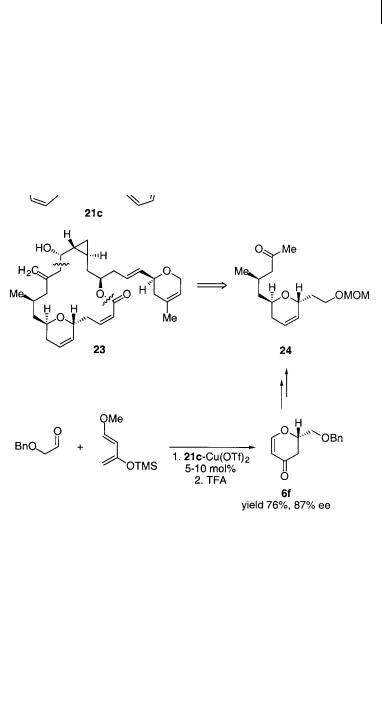
4.3 Cycloaddition Reactions of Carbonyl Compounds 169
mationally constrained BOX ligand 21c to compare the properties of the last ligand with the two others (Scheme 4.22) [34]. An ee of 72% and 70% yield of the cycloaddition product 6e were obtained using 21c-Cu(OTf)2, which for this particular reaction was a significant improvement compared with the two other catalysts. This methodology has been used for the synthesis of the C3–C14 segment 24 of the antitumor agent laulimalide 23 (Scheme 4.22) [35]. The constrained chiral BOX ligand 21c in combination with Cu(OTf)2 afforded dihydropyrane 6f by a cycloaddition reaction in good yield and ee; this was converted to the C3–C14 segment 24 via a Ferrier-type rearrangement in several steps.
6e
Scheme 4.22

170 4 Catalytic Enantioselective Cycloaddition Reactions of Carbonyl Compounds
Chiral BOX-zinc(II) complexes can also catalyze the cycloaddition reaction of glyoxylates with, e.g., 2,3-dimethyl-1,3-butadiene and 1,3-cyclohexadiene [36]. The reaction gave for the former diene a higher cycloaddition product/ene product ratio compared with the corresponding chiral copper(II) complexes; the ee, however, was slightly reduced. For the reaction of 1,3-cyclohexadiene slightly lower yield and ee were also found.
Desimoni et al. have found that chiral BOX-manganese(II) complexes can catalyze the intramolecular cycloaddition and ene reactions, with the latter as the major product [37].
The mechanism of, and especially the intermediate in, the cycloaddition reactions catalyzed by the chiral BOX-copper(II) complexes have received considerable attention because of the peculiar ligand effect on the asymmetric induction. On the basis of absolute configuration of the cycloaddition products obtained in the reaction of ethyl glyoxylate with conjugated dienes it was proposed that two different intermediates were operating, depending on the substituent attached to the chiral center in the BOX ligand [9]. It has been proposed that these two intermediates are tetrahedral (Scheme 4.23, 25) in which glyoxylate is coordinated to (S)-Ph- BOX-Cu(II) in a bidentate fashion, whereas a square-planar intermediate (Scheme 4.23, 26) could account for the absolute configuration of the cycloaddition products obtained in reactions catalyzed by (S)-t-Bu-BOX-Cu(II). The two different structural intermediates 25 and 26 enable the diene to approach the same face of the carbonyl functionality leading to the same absolute configuration in the product, although the absolute configuration of the chiral ligand is opposite.
Several chiral BOX-copper(II) catalysts 27a–c, 28a,b [31h, 38] and chiral BOXcopper(II) substrate/hydrolyzed enone complexes 29a,b [31f, 39] have been characterized by X-ray structure analysis (Scheme 4.24).
Chiral BOX-copper(II)-coordinated complexes can have different coordination geometries. When the coordination number is four copper(II) has distorted square-planar geometry with a dihedral angle in the range from = +7.0 o for the i-Pr-BOX-Cu(OH2)2 complex 27a to = +33.3 o for t-Bu-BOX-Cu(OH2)2 27b and= –9.3 for Ph-BOX-Cu(OH2)2 27c [38a]. When the coordination number is five the complex has square-pyramidal geometry 28a with the water molecules distorted 26 out of the plane [38 b]. For the (S)-Ph-BOX-Cu(OTf)2(OH2)2 complex, an octahedral complex is found 28b [31 h]. A chiral BOX-copper(II)-alkylidene malonate complex has a distorted square-planar geometry with an average distortion of 26 29a [31 f ]. In the inverse electron-demand cycloaddition reaction catalyzed by (S)-21b, a failed reaction with an enone gave a crystal of the anion of the hydrolyzed enone bound to the chiral BOX-copper(II) 29b, in which the average distortion of the two oxygen atoms was 23 [39]. If it is assumed that glyoxylate replaces the two water molecules in 27b, a chiral BOX-copper(II) substrate intermediate 25 is formed which can account for the experimentally observed stereochemical outcome of the reactions catalyzed by the t-Bu-BOX-Cu(II) and i-Pr-BOX- Cu(II) complexes. The structure of complexes 29a,b also supports the distorted square-planar intermediate 25 for reactions catalyzed by the t-Bu-BOX-Cu(II) complexes. The X-ray structure of the (S)-Ph-BOX-Cu(H2O)2 · 2SbF6 complex 27c can-
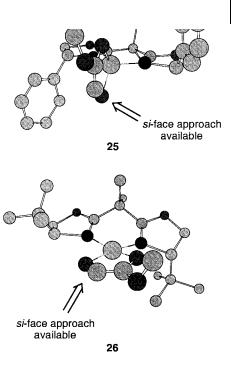
4.3 Cycloaddition Reactions of Carbonyl Compounds 171
Scheme 4.23
not, however, account for the absolute configuration of the cycloaddition products obtained by use of this catalyst, whereas the tetrahedral intermediate 26 does.
The above described X-ray structures were mainly obtained by Evans et al. They did not, however, propose any model that rationalizes the asymmetric induction by the Ph-BOX-Cu(II) catalyst in the original paper dealing with Diels-Alder reactions [40]. The same group recently published a paper concerning the opposite asymmetric induction of the catalysts Ph-BOX-Cu(II) and t-Bu-BOX-Cu(II) [38a]. Although they have not yet offered an explanation of this phenomenon, it was indicated that a tetrahedral copper(II) center was unlikely. The major arguments for this conclusion were the high endo selectivity observed from the cycloaddition and ene reactions catalyzed by Ph-BOX-Cu(II) and the lack of the obvious electronic effects from para-X-Ph-BOX ligands in combination with copper(II) salts. The ee of the product obtained in cycloaddition reactions using para-X-Ph-BOX ligands and copper(II) salts were: X = Cl: 89% ee; X = H: 93% ee; X = OMe: 93% ee. The unambiguous electronic effect of the para substituents on X-Ph-BOX ligands cannot exclude possible attractive catalyst-substrate ( -donor- -acceptor) interactions. To account for the enantioselective induction in reactions catalyzed by para-X-Ph-BOX- Cu(II) Evans et al. proposed a square-pyramidal geometry [38a].
Cationic BINAP-palladium and platinum complexes 30a,b can catalyze highly enantioselective cycloaddition reactions of arylglyoxals with acyclic and cyclic
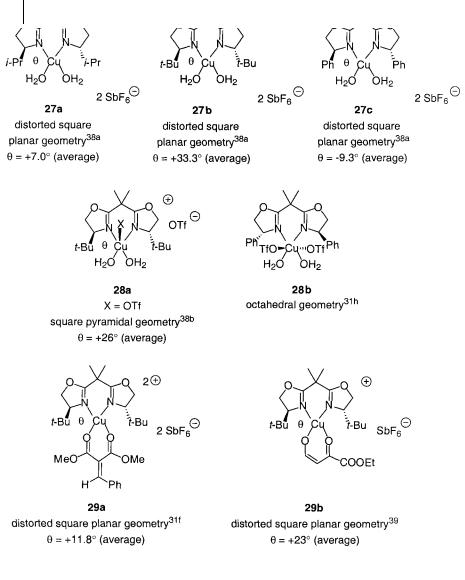
172 4 Catalytic Enantioselective Cycloaddition Reactions of Carbonyl Compounds
Scheme 4.24
dienes, as shown in Scheme 4.25 [41]. The cycloaddition reaction proceeds well for reaction of phenylglyoxal 4c with 2,3-dimethyl-1,3-butadiene 5a catalyzed by BINAP-Pd(II) and BINAP-Pt(II) giving 70% and 60% yield, and 99% and 97% ee, respectively, for the two catalysts. Enantioselective reactions catalyzed by 30a,b proceed with no ene product formation for para-substituted arylglyoxals and lead to good yields and high ee for acyclic and cyclic dienes, e.g., 1,3-cyclohexadiene, which gives 69% and 74% yield and > 99% ee of the endo diastereomer as the
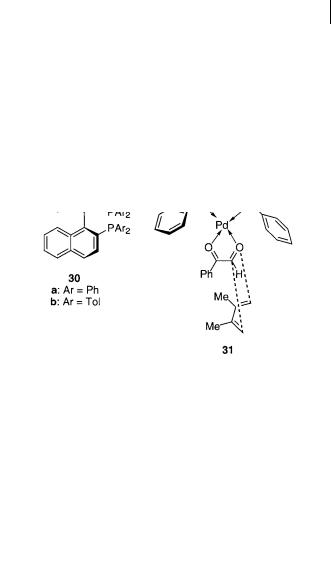
4.3 Cycloaddition Reactions of Carbonyl Compounds 173
only product for the two catalysts. When changing the dienophile to glyoxylate esters, the reaction with, e.g., 2,3-dimethyl-1,3-butadiene in the presence of 30a as the catalyst gave almost equal amounts of the cycloaddition and ene products [41b]. The selectivity of the cycloaddition product was excellent, with up to 98% ee. On the basis of the X-ray structure of the cationic palladium species coordinated with an (S)-BINAP ligand with slightly distorted square-planar geometry, it was proposed that the two carbonyl atoms of the phenyl glyoxal coordinate to the metal in a bidentate fashion as shown for 31. Because the approach of the diene to the si face of the formyl group is blocked by the equatorial phenyl group of the ligand, the diene attacks the re face to favor the observed (R) cyclo product [41b].
Scheme 4.25
Few investigations have included chiral lanthanide complexes as catalysts for cycloaddition reactions of activated aldehydes [42]. The reaction of tert-butyl glyoxylate with Danishefsky’s diene gave the expected cycloaddition product in up to 88% yield and 66% ee when a chiral yttrium bis-trifluoromethanesulfonylamide complex was used as the catalyst.

174 4 Catalytic Enantioselective Cycloaddition Reactions of Carbonyl Compounds
4.3.3
Reactions of Ketones
Because ketones are generally less reactive than aldehydes, cycloaddition reaction of ketones should be expected to be more difficult to achieve. This is well reflected in the few reported catalytic enantioselective cycloaddition reactions of ketones compared with the many successful examples on the enantioselective reaction of aldehydes. Before our investigations of catalytic enantioselective cycloaddition reactions of activated ketones [43] there was probably only one example reported of such a reaction by Jankowski et al. using the menthoxyaluminum catalyst 34 and the chiral lanthanide catalyst 16, where the highest enantiomeric excess of the cycloaddition product 33 was 15% for the reaction of ketomalonate 32 with 1-methoxy-1,3-butadiene 5e catalyzed by 34, as outlined in Scheme 4.26 [16].
Scheme 4.26
The C2-symmetric BOX-copper(II) complexes can also catalyze highly enantioselective cycloaddition reactions of -keto esters and -diketones with conjugated dienes [43]. Simple dienes, such as 2,3-dimethylbutadiene or 1,3-cyclohexadiene, do not react in a cycloaddition reaction with ethyl pyruvate 35a in the presence of chiral BOX-copper(II) complexes. The use of Danishefsky’s diene 2a, however, afforded the cycloaddition reaction (Scheme 4.27). Many different chiral BOX ligands were tested and it was found that the t-Bu-BOX-CuX2 21b catalyst is the best for the reaction shown in Scheme 4.27. The reaction is highly dependent on the counter-ions which have a significant effect on the yield and ee of the cycloaddition product 36a; triflate is superior to antimonate for this reaction, because it led to higher yield and ee in all the examples studied. This contrasts with previous observations [32, 44], but the better results using triflate in the current reaction could be that the triflate provides the suitable Lewis acidity for activating the dienophile, and/or the fluoride atoms contained in the antimonate might destroy, or interfere with, with the silyloxy-containing diene.
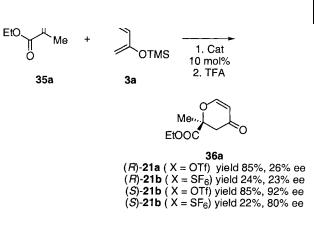
4.3 Cycloaddition Reactions of Carbonyl Compounds 175
Scheme 4.27
The cycloaddition reaction of activated dienes catalyzed by t-Bu-BOX-Cu(II) (S)- 21b is a reaction which can be used for different -dicarbonyl compounds 35. The results outlined in Scheme 4.28 shows the scope of the catalytic enantioselective reaction using 10 mol% of the catalyst. High yields and excellent ee of the cycloaddition products 36 were obtained in reactions of 35 with the activated dienes 2a,b. The results also show that the reaction proceeds well with good yield and very high ee for -diketones and -keto esters containing alkyl and phenyl substituents. These cycloaddition reactions can proceed to complete conversion using only 0.05 mol% of the catalyst (S)-21b (X = OTf) with only one enantiomer detected by chiral GC of the crude product [43b]. The very low catalyst loading was found to be quite general for different -dicarbonyl substrates and some representative results are also given in Scheme 4.28. The turn-over number for the reaction of methyl pyruvate with Danishefsky’s diene is 1800/mol catalyst (based on 90% yield using 0.05 mol% of the catalyst) for 20 h, or 90 mol–1 h–1. This is probably one of the lowest catalyst loadings, in addition to providing one of the highest turn-over numbers in Lewis acid-catalyzed enantioselective reactions.
The absolute configuration of the cycloaddition product obtained by the reaction of ketones with activated dienes catalyzed by (S)-t-Bu-BOX-Cu(II) (S)-21b points also to an intermediate in which the geometry around the central copper atom is square-planar similar to 26 above, and that the diene approaches the carbonyl functionality in an endo fashion.
The chiral BOX-metal(II) complexes can also catalyze cycloaddition reactions of other ketonic substrates [45]. The reaction of ethyl ketomalonate 37 with 1,3-conju- gated dienes, e.g. 1,3-cyclohexadiene 5c can occur with chiral BOX-copper(II) and zinc(II) complexes, Ph-BOX-Cu(OTf)2 (R)-21a, and Ph-BOX-Zn(OTf)2 (R)-39, as the catalysts (Scheme 4.29). The reaction proceeds with good yield and ee using the latter complex as the catalyst. Compared to the copper(II)-derived catalyst, which affects a much faster reaction, the use of the zinc(II)-derived catalyst is more convenient because the reaction gives 94% yield and 94% ee of the cycloaddition product 38. The cycloaddition product 38 can be transformed into the optically active CO2-
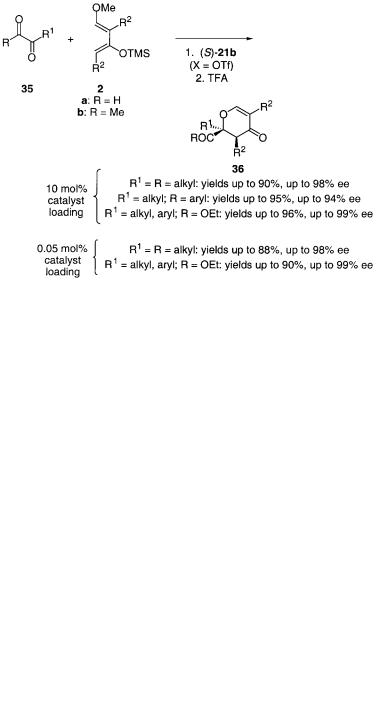
176 4 Catalytic Enantioselective Cycloaddition Reactions of Carbonyl Compounds
Scheme 4.28
synthon 40 which might have potential in organic synthesis, because it can be converted into diol 41 (Scheme 4.29), a key intermediate for the synthesis of, e.g., cyclohexenyl carbinols and anticapsin.
Scheme 4.29

4.3 Cycloaddition Reactions of Carbonyl Compounds 177
To account for the course of this reaction theoretical calculations of the coordination of ketomalonate 37 to copper(II) and zinc(II) have revealed that the sixmembered ring system is slightly more stable than the five-membered ring system (Scheme 4.30). The coordination of 37 to catalyst (R)-39 shows that the sixmembered intermediate is C2-symmetric with no obvious face-shielding of the carbonyl functionality (top), while for the five-membered intermediate (bottom) the carbonyl is shielded by the phenyl substituent. Calculations of the transition-state energy for the reaction of the two intermediates with 1,3-cyclohexadiene leads to the lowest energy for the five-membered intermediate; this approach is in agreement with the experimental results [45].
Scheme 4.30
